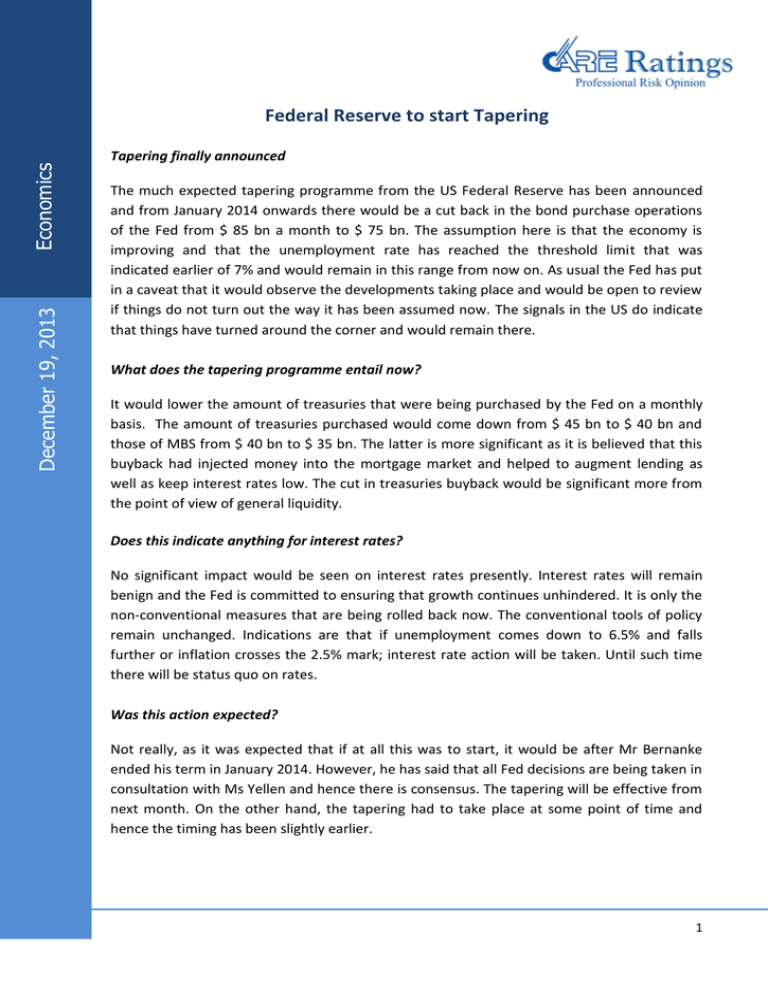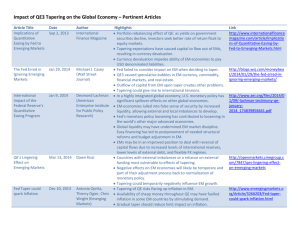Federal Reserve to start Tapering s ic m
advertisement

December 19, 2013 Economics Federal Reserve to start Tapering Tapering finally announced The much expected tapering programme from the US Federal Reserve has been announced and from January 2014 onwards there would be a cut back in the bond purchase operations of the Fed from $ 85 bn a month to $ 75 bn. The assumption here is that the economy is improving and that the unemployment rate has reached the threshold limit that was indicated earlier of 7% and would remain in this range from now on. As usual the Fed has put in a caveat that it would observe the developments taking place and would be open to review if things do not turn out the way it has been assumed now. The signals in the US do indicate that things have turned around the corner and would remain there. What does the tapering programme entail now? It would lower the amount of treasuries that were being purchased by the Fed on a monthly basis. The amount of treasuries purchased would come down from $ 45 bn to $ 40 bn and those of MBS from $ 40 bn to $ 35 bn. The latter is more significant as it is believed that this buyback had injected money into the mortgage market and helped to augment lending as well as keep interest rates low. The cut in treasuries buyback would be significant more from the point of view of general liquidity. Does this indicate anything for interest rates? No significant impact would be seen on interest rates presently. Interest rates will remain benign and the Fed is committed to ensuring that growth continues unhindered. It is only the non-conventional measures that are being rolled back now. The conventional tools of policy remain unchanged. Indications are that if unemployment comes down to 6.5% and falls further or inflation crosses the 2.5% mark; interest rate action will be taken. Until such time there will be status quo on rates. Was this action expected? Not really, as it was expected that if at all this was to start, it would be after Mr Bernanke ended his term in January 2014. However, he has said that all Fed decisions are being taken in consultation with Ms Yellen and hence there is consensus. The tapering will be effective from next month. On the other hand, the tapering had to take place at some point of time and hence the timing has been slightly earlier. 1 Economics How have the markets reacted? The US markets bounced up on this decision which was surprising in a way. When the news of tapering was first heard in May and subsequently, the markets interpreted it negatively and went down. This time however, the reaction was positive. One reason could be that the amount is small and that the complete withdrawal would take time. The other is that any tapering is good news for the economy as it indicates a reversal of fortunes for the US economy. What was QE all about? It must be remembered that quantitative easing was an unconventional mode of intervention by the Federal Reserve following the financial crisis of 2008. To begin with interest rates were brought down to close to zero to stimulate the system. But, when it did not work as banks did not trust one another and hence lend, the Federal Reserve decided to buy back securities from institutions which came in three stages. This led to a surge in liquidity which was transmitted to the emerging markets as investment in debt and equity markets. How about emerging markets? There will definitely be an impact on the countries which benefited from the QE programme as funds did flow into both equities and debt. The news of tapering prompted them to move away from the debt segments and thus put pressure on the balance of payments of the concerned countries and hence their exchange rates. When there are fewer funds to be invested overseas, howsoever small it may be for individual recipients, there will be some impact on funds flows. If the funds were being directed to debt, then interest rates will matter for potential investors. Further, exchange rate stability would be assessed when funds are taking a decision on in which country to invest. Will other central banks follow suit? Unlikely, as the ECB, BOJ and BOE would look at domestic conditions before going in for any withdrawal of their easing programmes. Will this affect India? Nearly $ 13 bn have flowed out from the debt segment of the market since June (till November) ever since the tapering announcement was made in May. Hence, the actual act of tapering will certainly have an impact. However, the Indian economy is better placed to face such an outflow as the balance of payments situation is stronger relative to May with the current account deficit coming down and additional capital funds being gathered through the swap scheme of the RBI. FII flows into equity have been Tapering by Fed 2 Economics positive $ 2.3 bn during this period, with the number being positive in the last three months. Hence, equity flows may still be determined by factors beyond interest rates, which will matter for debt flows. The RBI will be for sure monitoring developments in both the debt and equity markets till such time the first tapering takes place in January to assess the impact on not just our markets but also exchange rates before taking a call on domestic policy action. Contact: Madan Sabnavis Chief Economist madan.sabnavis@careratings.com 91-022-67543489 Anuja Jaripatke Associate Economist anuja.jaripatke@careratings.com 91-022-61443515 Disclaimer This report is prepared by the Economics Division of Credit Analysis & Research Limited [CARE]. CARE has taken utmost care to ensure accuracy and objectivity while developing this report based on information available in public domain. However, neither the accuracy nor completeness of information contained in this report is guaranteed. CARE is not responsible for any errors or omissions in analysis/inferences/views or for results obtained from the use of information contained in this report and especially states that CARE (including all divisions) has no financial liability whatsoever to the user of this report. Tapering by Fed 3




